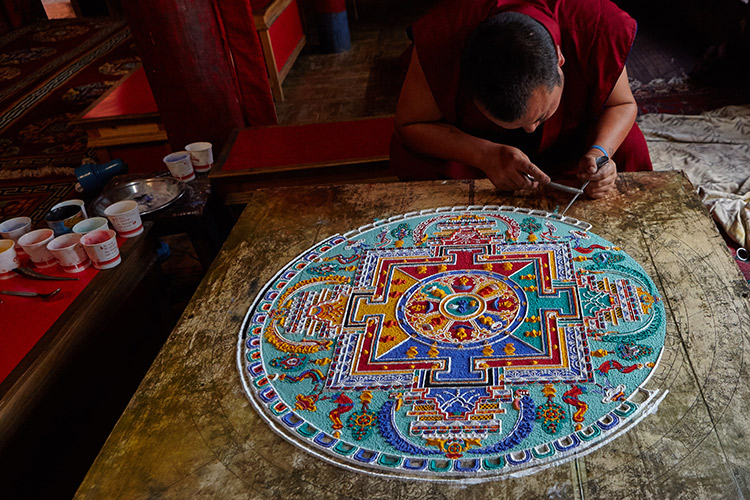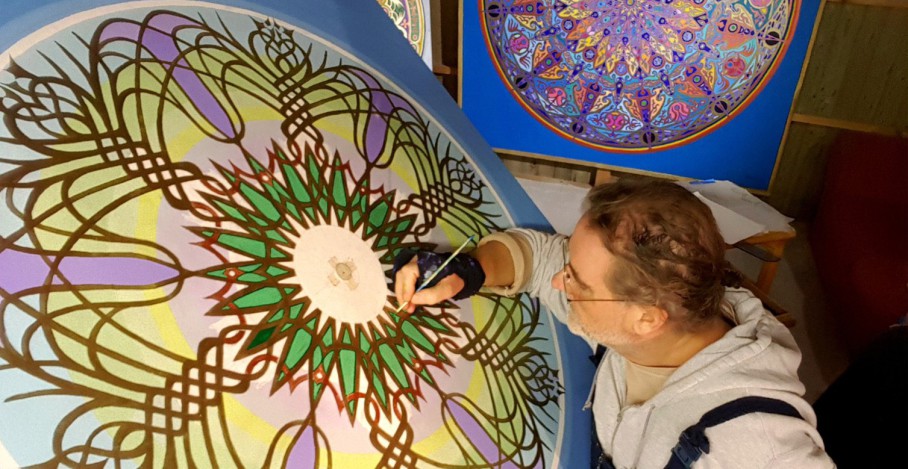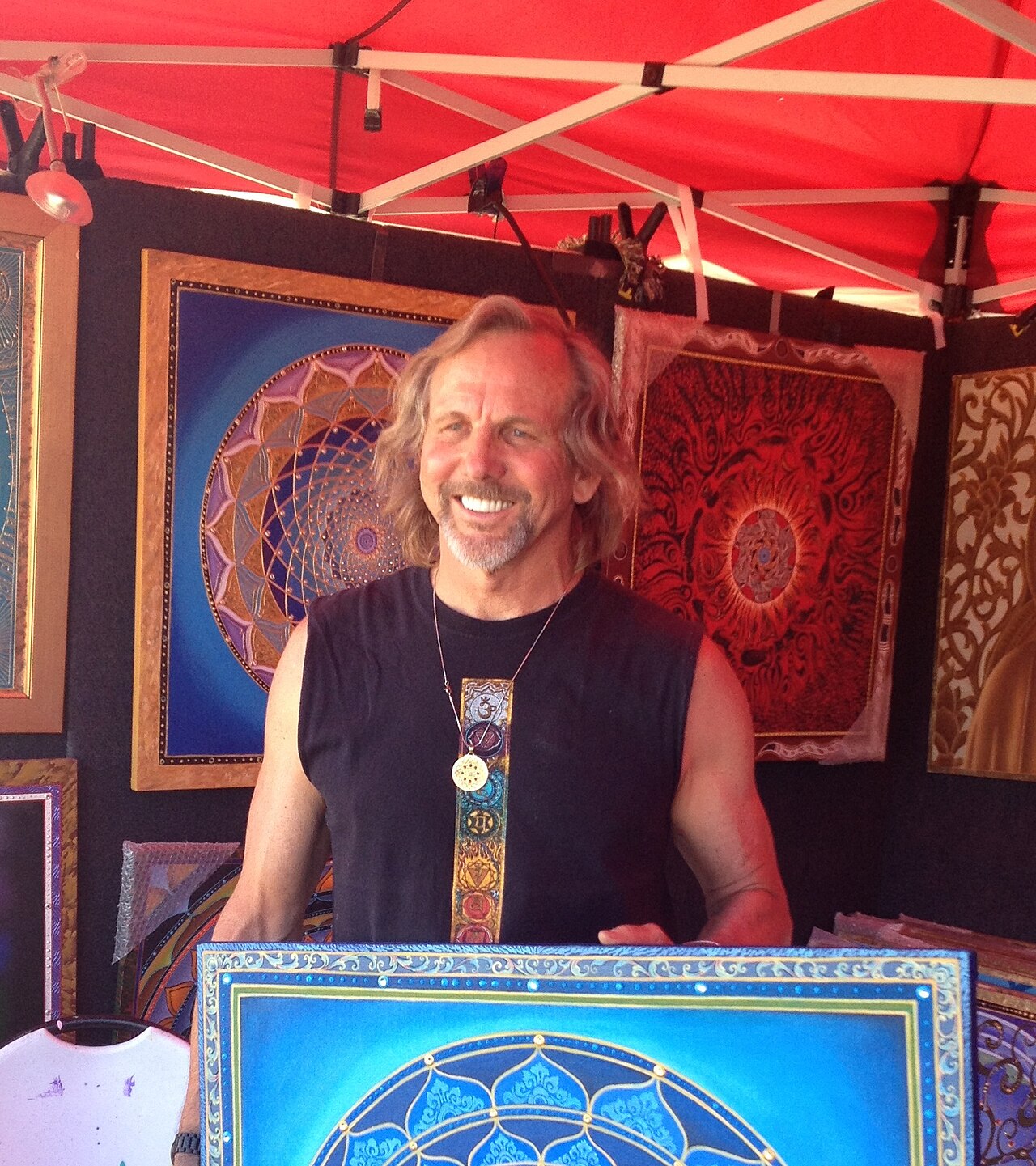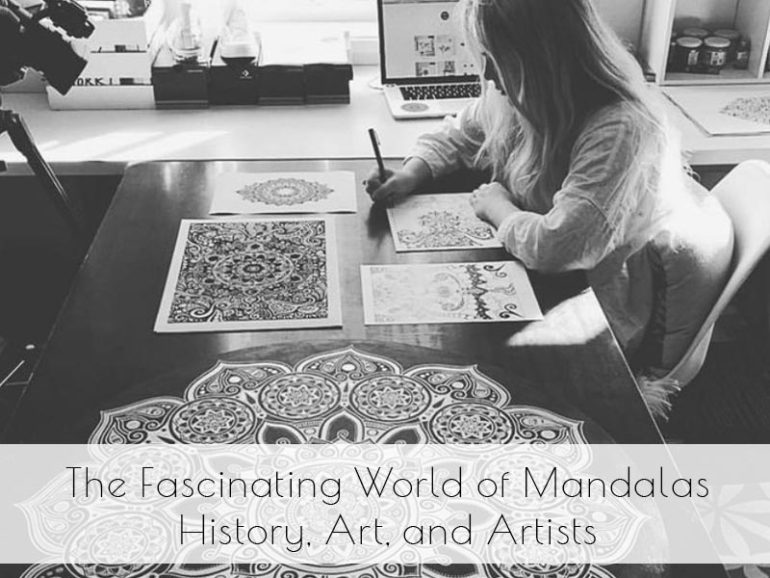Mandalas are intricate, symmetrical designs that hold deep spiritual and cultural significance. Originating in ancient religious traditions, they have been embraced by artists worldwide for their meditative and aesthetic qualities. Here we will explore the history of mandalas, highlight contemporary artists who create mandala art, and provide suggested artworks for students to study, including both colourful and black-and-white examples.
History of Mandalas
Mandalas have a rich history that spans several cultures and religious traditions, primarily in Asia.
- Origins: The term “mandala” comes from the ancient Sanskrit language and means “circle.” Mandalas first appeared in the religious art of Hinduism and Buddhism in India over 2,000 years ago. They were used as spiritual symbols and tools for meditation and rituals.
- Hinduism: In Hinduism, mandalas are used in meditation and rituals, symbolizing the universe and its cosmic order. They often feature deities and elaborate geometric patterns.
- Buddhism: Tibetan Buddhists create intricate sand mandalas as part of religious ceremonies. These mandalas are meticulously constructed and then destroyed to symbolize the impermanence of life.
- Spread to Other Cultures: Mandalas spread from India to other parts of Asia, including Tibet, China, and Japan, where they were adapted into local religious and artistic practices. In recent years, mandalas have gained popularity worldwide, transcending their religious origins to become a universal symbol of harmony and balance.

Key Artists Who Create Mandala Art
Contemporary artists around the world have embraced mandalas, creating stunning works that range from vibrant colour pieces to intricate black-and-white designs.
Stephen Meakin is a contemporary mandala artist whose intricate and mesmerizing works have captivated audiences around the world. His art combines traditional mandala elements with a modern aesthetic, creating visually stunning pieces that evoke a sense of balance and harmony. Meakin’s meticulous attention to detail and his mastery of both colour and form are evident in each of his creations.
His mandalas often feature intricate geometric patterns and symmetrical designs, crafted with precision and care. Through his art, Meakin aims to inspire mindfulness and inner peace, inviting viewers to explore the deeper meanings and meditative qualities of mandalas. His work has been showcased in numerous exhibitions, and he continues to be a significant figure in the contemporary mandala art scene.

- Paul Heussenstamm: An American artist known for his colourful mandalas, Heussenstamm’s work is deeply inspired by spiritual themes. His vibrant designs are used as tools for meditation and personal reflection.

Jamie Lock is a distinguished mandala artist known for her intricate and captivating designs that blend traditional techniques with contemporary flair. Her work is characterized by detailed geometric patterns and symmetrical compositions, often created using vibrant colours and delicate line work. Lock’s mandalas are not only visually stunning but also imbued with a sense of tranquillity and spiritual depth, reflecting her passion for mindfulness and meditation.
She expertly uses both digital tools and traditional media to craft her art, allowing for a fusion of old and new methods. Jamie Lock’s mandalas have been featured in numerous exhibitions and publications, earning her recognition in the art community. Through her creations, she invites viewers to experience a moment of peace and introspection, highlighting the therapeutic and meditative qualities of mandala art.
Techniques and Practices in Mandala Art
Creating mandalas involves a blend of geometric precision and creative expression. Here are some common techniques and practices used by mandala artists:
- Drawing and Painting: Artists often start with a central point and work outward, using compasses and rulers to ensure symmetry. They may use a variety of mediums, including ink, watercolour, acrylics, and digital tools.
- Sand Mandalas: Tibetan monks create sand mandalas using coloured sand. This intricate process involves hours or even days of work, only to be swept away upon completion, symbolizing the impermanence of existence.
- Digital Mandalas: Modern technology has allowed artists to create mandalas using digital tools. These digital mandalas can be animated, allowing for interactive and dynamic designs.
Benefits and Uses of Mandalas
Mandalas are not only visually appealing but also offer various psychological and spiritual benefits.
- Meditative and Therapeutic: Drawing or colouring mandalas can be a meditative practice, helping to reduce stress and promote relaxation. The repetitive patterns and symmetry encourage focus and mindfulness.
- Symbolic Meaning: Each mandala has its own symbolic meaning, often representing concepts such as unity, balance, and harmony. They are used in various spiritual practices to aid in meditation and contemplation.
View artist Fortyonehundred who is in full time self employment being commissioned full time for her work. Her mandalas have been featured in numerous exhibitions and publications, garnering recognition and acclaim within the art community. Visit her channel to see her amazing studio setup and follow her art videos too, we know you will find them all truly inspiring!
Mandalas are a beautiful and profound form of art with deep historical roots and contemporary relevance. From their origins in ancient religious traditions to their adoption by modern artists, mandalas continue to captivate and inspire. Whether colourful or black-and-white, intricate or simple, each mandala carries a sense of balance and harmony that resonates with viewers.
If you would like to receive a roundup of all of our blog posts once a week to keep you inspired in your inbox, why not sign up to our newsletter. You can access our sign up at the top of our page. If you are a London Art College student and you would like your artwork featured here, drop us a line at any time.

